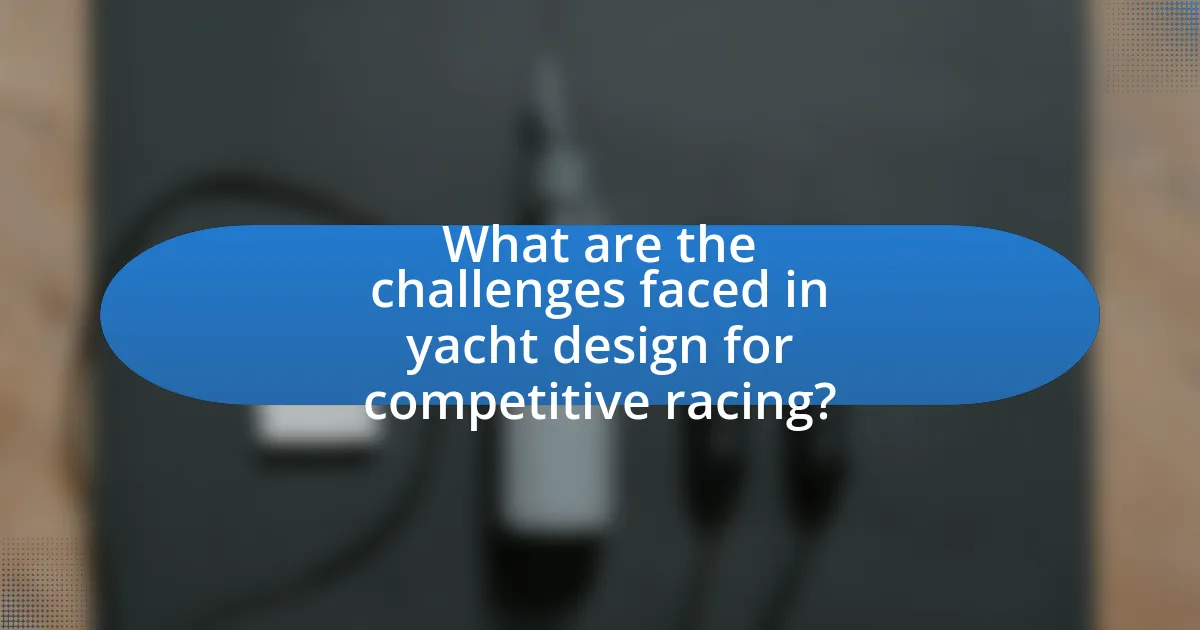The article focuses on innovations in yacht design for competitive racing, highlighting advancements in materials, technology, and design principles that enhance performance. Key innovations include the use of lightweight materials such as carbon fiber, aerodynamic hull shapes, and sophisticated sail technologies that optimize speed and maneuverability. The article also discusses the evolution of materials from traditional wood to advanced composites, the role of computer simulations in design, and the impact of environmental factors on performance. Additionally, it addresses the influence of racing regulations on design strategies and the growing trend towards sustainability in yacht construction.

What are the key innovations in yacht design for competitive racing?
Key innovations in yacht design for competitive racing include the use of advanced materials, aerodynamic hull shapes, and sophisticated sail technology. Advanced materials such as carbon fiber and Kevlar have significantly reduced weight while increasing strength, allowing for faster and more agile yachts. Aerodynamic hull shapes, designed using computational fluid dynamics, minimize drag and enhance speed, as seen in the latest America’s Cup yachts. Additionally, innovations in sail technology, including wing sails and adaptive rigging systems, optimize performance by maximizing wind capture and adjusting to varying conditions. These innovations collectively contribute to improved speed, maneuverability, and overall racing performance.
How have materials evolved in yacht design?
Materials in yacht design have evolved significantly from traditional wood to advanced composites and lightweight metals. Initially, wooden hulls dominated yacht construction, providing durability but limiting performance due to weight. The introduction of fiberglass in the 1960s revolutionized yacht design, offering a lighter, more flexible alternative that improved speed and maneuverability.
In recent years, the use of carbon fiber and other advanced composites has further enhanced performance, allowing for stronger, lighter structures that can withstand harsh marine environments. For instance, carbon fiber-reinforced plastics are now commonly used in high-performance racing yachts, contributing to weight reductions of up to 30% compared to fiberglass.
Additionally, innovations in materials science have led to the development of nanomaterials and smart materials, which can adapt to environmental conditions, enhancing both performance and safety. These advancements reflect a trend towards optimizing yacht design for competitive racing, where every ounce of weight and every structural advantage can significantly impact speed and agility on the water.
What new materials are being used in modern yacht construction?
Modern yacht construction increasingly utilizes advanced materials such as carbon fiber, epoxy resins, and aluminum alloys. Carbon fiber is favored for its high strength-to-weight ratio, allowing for lighter and faster yachts, while epoxy resins enhance durability and resistance to environmental factors. Aluminum alloys provide a balance of strength and weight, making them suitable for both hulls and superstructures. These materials contribute to improved performance and efficiency in competitive racing, as evidenced by their widespread adoption in high-performance racing yachts like the America’s Cup contenders.
How do these materials enhance performance and durability?
Advanced materials such as carbon fiber and high-strength composites enhance performance and durability in yacht design by providing superior strength-to-weight ratios and resistance to environmental factors. Carbon fiber, for instance, is significantly lighter than traditional materials like aluminum or steel, allowing for faster speeds and improved maneuverability. Additionally, these materials exhibit high resistance to corrosion and fatigue, which extends the lifespan of the yacht and reduces maintenance costs. Research indicates that yachts constructed with these advanced materials can achieve up to 30% better performance in competitive racing scenarios compared to those made with conventional materials, demonstrating their effectiveness in enhancing both performance and durability.
What role does technology play in yacht design?
Technology plays a crucial role in yacht design by enhancing performance, efficiency, and safety. Advanced computer-aided design (CAD) software allows designers to create precise models and simulations, optimizing hull shapes for speed and stability. Additionally, materials technology, such as the use of carbon fiber and lightweight composites, significantly reduces weight while increasing strength, which is essential for competitive racing. Furthermore, innovations in hydrodynamics and aerodynamics, supported by computational fluid dynamics (CFD) analysis, enable designers to refine sail shapes and underwater profiles, improving overall performance. These technological advancements have been pivotal in the evolution of yacht design, leading to faster and more competitive vessels in racing events.
How are computer simulations and modeling used in the design process?
Computer simulations and modeling are integral to the design process in yacht design for competitive racing by allowing designers to test and optimize various design parameters virtually. These tools enable the analysis of hydrodynamics, structural integrity, and performance under different conditions without the need for physical prototypes. For instance, Computational Fluid Dynamics (CFD) simulations can predict how water flows around the yacht’s hull, leading to design adjustments that enhance speed and stability. Additionally, finite element analysis (FEA) can assess the strength of materials used in construction, ensuring that the yacht can withstand the stresses of racing. The use of these simulations significantly reduces development time and costs while improving the overall performance of the yacht, as evidenced by the successful implementation of these techniques in recent America’s Cup designs, where teams have achieved record-breaking speeds through iterative modeling and testing.
What advancements in navigation and communication technology are impacting racing yachts?
Advancements in navigation and communication technology significantly impact racing yachts by enhancing real-time data analysis and connectivity. Technologies such as GPS, AIS (Automatic Identification System), and advanced weather routing software provide sailors with precise positioning, collision avoidance, and optimal sailing routes. For instance, the integration of satellite communication systems allows for continuous data exchange, enabling teams to receive live updates on weather conditions and competitor positions. These advancements improve decision-making and strategic planning during races, ultimately increasing competitiveness and performance on the water.
How do aerodynamic and hydrodynamic designs influence yacht performance?
Aerodynamic and hydrodynamic designs significantly enhance yacht performance by reducing drag and improving stability. Aerodynamic features, such as streamlined sails and hull shapes, minimize air resistance, allowing yachts to achieve higher speeds with less energy. Hydrodynamic designs, including optimized hull forms and appendages like keels and rudders, reduce water resistance and improve maneuverability. For instance, the use of foils in modern racing yachts can lift the hull out of the water, drastically decreasing drag and increasing speed. Studies have shown that yachts with advanced aerodynamic and hydrodynamic designs can outperform traditional models by up to 30% in speed under similar conditions, demonstrating the critical role these designs play in competitive racing.
What are the principles of aerodynamics applied in yacht design?
The principles of aerodynamics applied in yacht design include lift generation, drag reduction, and airflow management. Lift generation is crucial for enhancing the yacht’s speed and stability, achieved through the shape of the sails and hull, which are designed to create a pressure difference. Drag reduction focuses on minimizing resistance against the yacht’s movement, accomplished by streamlining the hull and optimizing sail shape to reduce turbulence. Airflow management involves controlling how air interacts with the yacht’s surfaces, ensuring efficient sail performance and stability during racing conditions. These aerodynamic principles are validated by wind tunnel testing and computational fluid dynamics simulations, which demonstrate their effectiveness in improving yacht performance in competitive racing scenarios.
How does hull shape affect speed and stability in competitive racing?
Hull shape significantly influences both speed and stability in competitive racing yachts. A streamlined hull reduces drag, allowing for higher speeds, while a wider beam enhances stability, particularly in rough waters. For instance, research indicates that a V-shaped hull can cut through waves more efficiently, improving speed, while a flat-bottomed hull provides greater stability at lower speeds. The balance between these shapes is crucial; a design that prioritizes speed may compromise stability, affecting overall performance. Therefore, the choice of hull shape is a critical factor in yacht design, directly impacting racing outcomes.

What are the latest trends in competitive yacht racing design?
The latest trends in competitive yacht racing design include the increased use of foiling technology, advanced materials, and data-driven performance optimization. Foiling technology allows yachts to lift above the water, reducing drag and increasing speed, as seen in the America’s Cup teams utilizing hydrofoils for enhanced performance. Advanced materials, such as carbon fiber and composites, are being employed to create lighter and stronger hulls, improving overall efficiency and handling. Additionally, teams are leveraging data analytics and simulation tools to refine design and sailing strategies, which has become essential for gaining a competitive edge in races. These trends reflect a significant shift towards innovation and technology in yacht racing design.
How is sustainability influencing yacht design for racing?
Sustainability is significantly influencing yacht design for racing by driving the adoption of eco-friendly materials and energy-efficient technologies. Designers are increasingly utilizing lightweight, recyclable materials such as carbon fiber and bio-resins to reduce the environmental impact while enhancing performance. Additionally, the integration of renewable energy sources, like solar panels and hydro-generators, is becoming common, allowing yachts to operate with minimal reliance on fossil fuels. This shift not only meets regulatory requirements but also appeals to a growing market of environmentally conscious consumers, as evidenced by the International Maritime Organization’s 2020 strategy to reduce greenhouse gas emissions from shipping by at least 50% by 2050.
What eco-friendly materials and practices are being adopted?
Eco-friendly materials and practices being adopted in yacht design for competitive racing include the use of sustainable composites, such as bio-resins and recycled carbon fiber, which reduce environmental impact while maintaining performance. Additionally, practices like energy-efficient manufacturing processes and the integration of renewable energy sources, such as solar panels, are increasingly implemented to minimize carbon footprints. Research indicates that using bio-based materials can reduce greenhouse gas emissions by up to 50% compared to traditional materials, demonstrating a significant shift towards sustainability in the industry.
How do sustainable designs impact racing performance?
Sustainable designs enhance racing performance by optimizing weight, improving aerodynamics, and utilizing eco-friendly materials that maintain structural integrity. For instance, lightweight composite materials, often derived from sustainable sources, reduce overall yacht weight, allowing for faster speeds and better maneuverability. Additionally, aerodynamic shapes designed with sustainability in mind can minimize drag, leading to improved fuel efficiency and speed. Research indicates that yachts incorporating sustainable design principles can achieve performance gains of up to 10% compared to traditional designs, demonstrating that eco-conscious innovations directly contribute to competitive advantages in racing.
What innovations are being made in sail technology?
Innovations in sail technology include the development of advanced materials, such as carbon fiber and aramid fibers, which enhance durability and reduce weight. These materials allow for the creation of sails that are not only stronger but also more efficient in capturing wind. Additionally, the integration of computational fluid dynamics (CFD) in sail design enables precise shaping and optimization of sail profiles, improving performance in various wind conditions. Research conducted by the University of Southampton highlights that these advancements can lead to increased speed and maneuverability in competitive racing yachts.
How have sail designs changed to improve efficiency and speed?
Sail designs have evolved significantly to enhance efficiency and speed through advancements in materials, shape, and technology. Modern sails utilize lightweight, durable materials such as carbon fiber and Mylar, which reduce drag and increase performance. Additionally, the introduction of wing sails, which have a rigid structure, allows for better airflow and lift compared to traditional soft sails. The shape of sails has also been optimized, with designs like the high-aspect ratio and camber-enhanced sails improving aerodynamic efficiency. These innovations have been validated by competitive racing results, where yachts employing these advanced sail designs consistently outperform traditional models in speed trials and regattas.
What role do smart sails play in competitive racing?
Smart sails enhance performance in competitive racing by optimizing sail shape and trim in real-time based on environmental conditions. These advanced sails utilize sensors and software to analyze wind patterns and adjust their configuration automatically, leading to improved speed and maneuverability. For instance, teams using smart sails can gain a competitive edge by responding swiftly to changes in wind direction and intensity, which is crucial in high-stakes racing scenarios. This technology has been shown to increase overall race efficiency, as evidenced by the success of teams employing smart sail systems in major regattas, where they consistently outperform traditional sail designs.
What are the implications of rule changes on yacht design?
Rule changes significantly impact yacht design by altering performance parameters and influencing material choices. For instance, the introduction of the International America’s Cup Class (IACC) rules in the 1990s led to the development of lighter, more aerodynamic hulls, enhancing speed and maneuverability. Additionally, changes in measurement rules can prompt designers to innovate with new technologies, such as foiling systems, which were adopted following the 2013 America’s Cup rule modifications. These adaptations not only improve competitiveness but also drive advancements in engineering and sustainability within the yacht design industry.
How do racing regulations influence design innovations?
Racing regulations significantly influence design innovations by establishing specific parameters that designers must adhere to, which often drives creativity and technological advancement. For instance, the International Sailing Federation (ISAF) sets rules that dictate hull dimensions, sail area, and weight limits, compelling designers to innovate within these constraints. Historical examples include the development of lightweight materials and advanced hydrodynamic shapes in response to the need for speed and efficiency under the rules of various racing classes. These regulations not only shape the physical attributes of yachts but also encourage the integration of cutting-edge technologies, such as computer-aided design and simulation tools, to optimize performance while remaining compliant with the established guidelines.
What recent rule changes have prompted new design strategies?
Recent rule changes in competitive yacht racing, particularly the introduction of the World Sailing’s new rule on sail area limitations and hull design specifications, have prompted innovative design strategies among yacht builders. These changes aim to enhance performance while ensuring fair competition, leading designers to explore lightweight materials and advanced hydrodynamic shapes. For instance, the 2021 rule adjustments allowed for increased flexibility in keel design, which has resulted in the development of more efficient and faster keels that optimize stability and speed. This shift in regulations has driven the adoption of computational fluid dynamics in the design process, enabling more precise modeling of yacht performance under varying conditions.

What are the challenges faced in yacht design for competitive racing?
The challenges faced in yacht design for competitive racing include balancing speed, stability, and weight while adhering to class rules. Designers must optimize hull shape and materials to enhance performance without exceeding regulatory limits, which can restrict innovative features. Additionally, the integration of advanced technology, such as foiling systems and sail design, requires extensive testing and refinement to ensure reliability under race conditions. Historical data shows that even minor design changes can significantly impact race outcomes, highlighting the importance of precision in the design process.
What are the common design limitations in competitive racing yachts?
Common design limitations in competitive racing yachts include weight restrictions, hull shape constraints, and limitations on sail area. These factors directly impact the yacht’s speed, maneuverability, and overall performance. For instance, the International Sailing Federation (ISAF) imposes strict weight limits to ensure fair competition, which can restrict the use of advanced materials that may enhance performance. Additionally, the design of the hull must adhere to specific shapes to optimize hydrodynamics, limiting innovative designs that could provide competitive advantages. Furthermore, regulations often cap sail area to maintain balance and prevent overpowering the yacht, which can hinder potential speed gains. These limitations are critical in shaping the design and engineering decisions made by yacht builders and designers.
How do weight restrictions affect design choices?
Weight restrictions significantly influence design choices in yacht construction by necessitating the use of lighter materials and innovative engineering techniques. Designers must prioritize weight-saving strategies, such as incorporating advanced composites like carbon fiber and optimizing hull shapes to reduce drag while maintaining structural integrity. For instance, the International Sailing Federation imposes specific weight limits for different classes of racing yachts, which drives manufacturers to innovate in material science and design methodologies to enhance performance without exceeding these limits. This focus on weight reduction directly correlates with improved speed and maneuverability, essential factors in competitive racing scenarios.
What challenges arise from balancing speed and stability?
Balancing speed and stability in yacht design presents significant challenges, primarily due to the inherent trade-offs between these two critical performance factors. High-speed designs often compromise stability, leading to increased risk of capsizing or loss of control, particularly in rough waters. Conversely, designs focused on stability may sacrifice speed, resulting in slower race times and reduced competitiveness.
For instance, the use of lightweight materials can enhance speed but may reduce the yacht’s overall stability, as seen in the development of foiling yachts, which rely on hydrofoils to lift the hull out of the water for reduced drag. This design choice can lead to instability in choppy conditions, making it difficult for sailors to maintain control. Additionally, the balance is affected by factors such as hull shape, weight distribution, and sail configuration, all of which must be meticulously optimized to achieve an effective compromise between speed and stability.
Research in yacht design, such as the study by van Oossanen and van der Meer (2019) in the Journal of Marine Science and Engineering, highlights the complexities of achieving this balance, demonstrating that even minor adjustments in design can significantly impact performance outcomes.
How do environmental factors impact yacht design?
Environmental factors significantly impact yacht design by influencing the materials, shape, and performance characteristics required for optimal functionality in various conditions. For instance, yachts designed for racing in rough seas must incorporate hydrodynamic shapes and durable materials to withstand high waves and strong winds, which can lead to innovations like reinforced hulls and advanced sail designs. Additionally, factors such as temperature and humidity affect the choice of materials; for example, lightweight composites are often used to enhance speed while ensuring resilience against environmental stressors. Research indicates that yachts designed with specific environmental conditions in mind can achieve up to 20% better performance in competitive racing scenarios, demonstrating the critical role of environmental considerations in yacht design.
What considerations must be made for different racing conditions?
Different racing conditions require specific considerations regarding yacht design, performance optimization, and crew strategy. For instance, in light winds, yachts must have a larger sail area and lighter hulls to maximize efficiency and speed. Conversely, in heavy winds, designs should focus on stability and control, often incorporating features like reefable sails and deeper keels to prevent capsizing. Additionally, sea state impacts hull design; choppy waters necessitate a hull shape that minimizes drag and enhances maneuverability. Historical data shows that yachts optimized for specific conditions, such as the America’s Cup competitors, often outperform those with generalized designs, highlighting the importance of tailoring design to environmental factors.
How do weather patterns influence design decisions?
Weather patterns significantly influence design decisions in yacht design for competitive racing by dictating the materials, hull shapes, and sail configurations used. For instance, yachts designed for regions with frequent high winds may feature reinforced hulls and smaller sails to enhance stability and control, while those intended for calmer waters might prioritize larger sails for increased speed. Historical data shows that the 2013 America’s Cup saw teams like Oracle Team USA adapt their designs based on weather forecasts, leading to innovations such as adjustable wing sails that optimized performance across varying wind conditions. This adaptability to weather patterns is crucial for maximizing competitive advantage in racing scenarios.
What are the best practices for optimizing yacht design for racing?
The best practices for optimizing yacht design for racing include focusing on hull shape, weight reduction, sail area optimization, and advanced materials. A streamlined hull shape minimizes drag and enhances speed, while reducing weight improves acceleration and maneuverability. Optimizing sail area ensures maximum power generation in varying wind conditions, and utilizing advanced materials like carbon fiber increases strength while decreasing weight. These practices are supported by the success of racing yachts like the America’s Cup contenders, which have consistently employed these design principles to achieve superior performance on the water.
How can designers effectively test and iterate on new designs?
Designers can effectively test and iterate on new designs by employing a combination of prototyping, user feedback, and data analysis. Prototyping allows designers to create tangible models of their concepts, enabling them to assess functionality and aesthetics in a real-world context. User feedback is crucial, as it provides insights into how actual users interact with the design, highlighting areas for improvement. Data analysis, including performance metrics and user engagement statistics, further informs the iterative process by identifying trends and issues that need addressing. This approach is supported by studies showing that iterative design processes lead to higher user satisfaction and better overall performance in competitive environments, such as yacht racing, where precision and innovation are critical.
What strategies can be employed to stay ahead in yacht design innovations?
To stay ahead in yacht design innovations, employing a strategy of continuous research and development is essential. This involves investing in advanced materials and technologies, such as carbon fiber and hybrid propulsion systems, which enhance performance and sustainability. Additionally, collaboration with naval architects and engineers can lead to innovative design solutions that improve aerodynamics and hydrodynamics. Historical examples, such as the use of foiling technology in the America’s Cup yachts, demonstrate how embracing cutting-edge design can significantly enhance competitive advantage. Furthermore, staying informed about industry trends and participating in design competitions can foster creativity and inspire new ideas, ensuring that yacht designs remain at the forefront of innovation.


